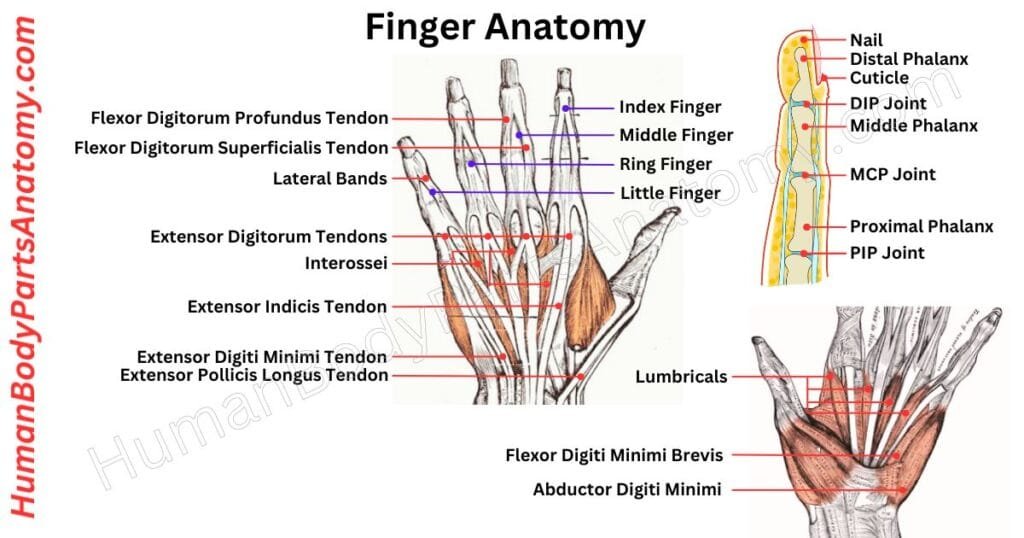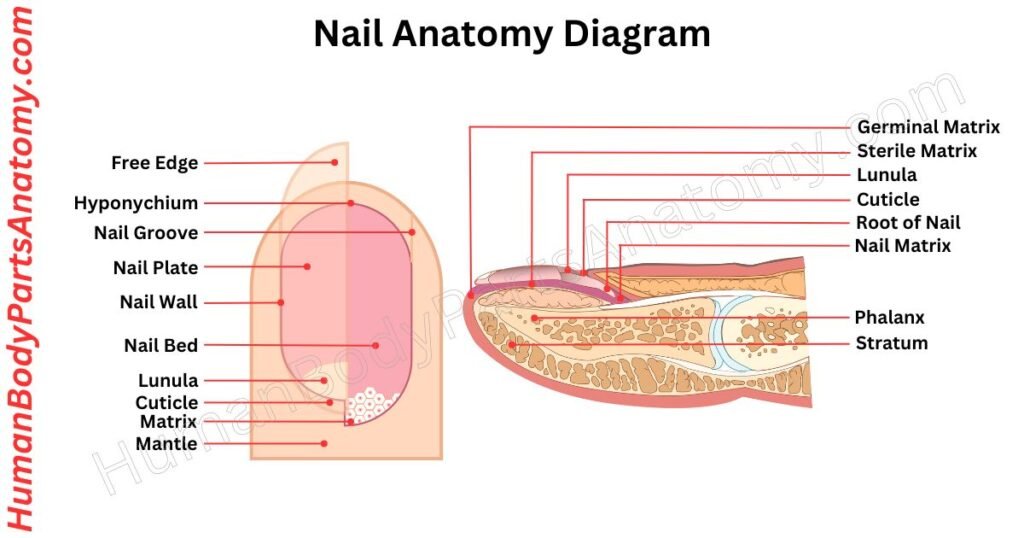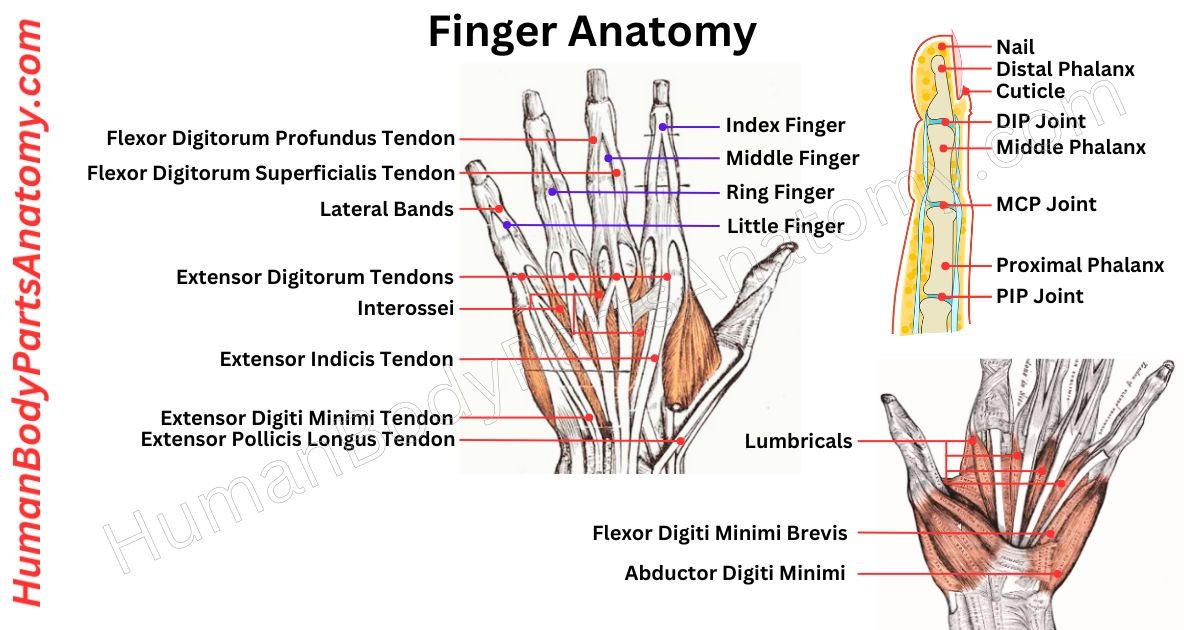Overview of Finger Anatomy
Fingers are essential limbs of the body, serving as specialized organs for manipulation and sensation. It is found in the hands of most tetrapods, including humans and other primates. They have undergone millions of years of evolution, developing into exceptional abilities. The anatomy of fingers is a complex network of tissues comprising muscle fibers, tendons, ligaments, nerves, and blood vessels. At the heart of finger anatomy lie the phalanges, a series of small bones that provide structure. Surrounded by muscles and tendons, these phalanges enable precise movements and intricate control, granting fingers remarkable versatility.
In this article, we will see the finger anatomy with its different parts and functions to get detailed information about the fingers.
Finger Anatomy Diagram

Parts of the Finger
Muscles
- Flexor Digitorum Profundus
- Flexor Digitorum Superficialis
- Extensor Digitorum
- Lumbricals
- Interossei
Joints
- Metacarpophalangeal (MCP) Joint
- Proximal Interphalangeal (PIP) Joint
- Distal Interphalangeal (DIP) Joint
Tendons
- Flexor Digitorum Profundus
- Flexor Digitorum Superficialis
- Flexor Pollicis Longus
- Extensor Digitorum
Ligaments
- Collateral ligaments
- Volara plate
- Palmar ligaments
- Dorsal ligaments
- Sagittal bands
Finger Parts
- Nail
- Phalanx bones
- Blood vessels
- Nerves
- Pulp
- Sesamoid bones
Finger Anatomy: Parts & Functions
Finger Joint Anatomy
The finger joints let us perform various movements with precision and accuracy. These joints are necessary for bending, straightening, twisting, and grasping objects.
Metacarpophalangeal (MCP) Joint
The bottom part of the pinky finger connects to the head of the fifth metacarpal bone, forming the metacarpophalangeal (MCP) joint. It can bend, flex, twist, turn, and move in various directions.
This joint is kept together by some tough ligaments and lubricated by a smooth substance called synovial fluid.
Proximal Interphalangeal (PIP) Joint
This joint is located in the middle of your finger and can only move in one direction – bending or straightening.
The joint plays a crucial role in gripping and grasping objects. The surrounding tough ligaments provide stability and prevent injury.
Distal Interphalangeal (DIP) Joint
It is a tiny joint at the tip of your finger. This joint might be small and move in one direction.
This joint is essential for all intricate finger movements, from playing musical instruments to typing on a keyboard.
Finger Tendon Anatomy
Flexor Digitorum Profundus
FDP tendons help bend the fingers at the fingertip joint. The same muscles regulate them as the rest of the fingers. This muscle is divided into four tendons that go down the forearm via the carpal tunnel and finally join to the fingertip bone.
In contrast to other flexors in the hand, these tendons travel within protective sheaths along the hand and fingers near the bone.
Flexor Digitorum Superficialis
FDS tendons play a vital role in bending the middle joints of the index, middle, ring, and little fingers. A shared muscle powers them, split into four tendons that run from the forearm into the carpal tunnel. They smoothly slide in sheaths along the fingers and hands.
At the finger level, each tendon separates into two cords. Independently enter the middle bone on either side of the flexor digitorum profundus tendon and continue down to the finger. This intricate system ensures coordinated and efficient finger movement.
Extensor Digitorum Communis
The EDC (Extensor Digitorum Communis) tendons extend from the forearm to your fingertips. Their primary responsibility is to straighten the index, middle, ring, and little fingers.
They run down the forearm, passing through the retinaculum, which keeps them in place. In hand these tendons work together to expand the fingers’ joints, providing for smooth and coordinated movement.
Extensor Digiti Minimi Tendon
The EDM muscle is crucial for straightening the little finger. Located in the forearm, it works with another muscle to control the small finger’s movement. Its tendon passes through a wristband (retinaculum) for support, allowing smooth movement.
Surprisingly, fewer than half of people have this tendon. The EDM, along with other tendons, ensures the straightening of the three joints in the small finger.
Finger Ligaments Anatomy
Collateral Ligaments
The collateral ligaments on either side of the finger joint possess impressive ligaments. They have a complex arrangement of collagen fibers, giving them incredible strength and flexibility.
The collateral ligaments act as a shield. They protect the joint from unwanted stresses and strains. They also allow us to perform intricate movements easily.
Volara Plate
The volar plate ligament is found in the fingers, located on the palmar side of the finger joint. This structure comprises a complex matrix of collagen fibers and glycosaminoglycans, giving it unique properties.
The volar plate is essential in providing stability to the joint. It acts as a protective barrier for the flexor tendons, enabling finger bending. It allows it to absorb and distribute forces evenly and helps prevent injury to the joint.
Palmar & Dorsal Ligaments
The palmar and dorsal ligaments play a crucial role in finger movement. The palmar ligaments are located on the palm side of the finger and are essential in preventing joint hyperextension.
These ligaments are highly organized collagen fibers that provide strength and stability to the joint. On the other hand, the dorsal ligaments are located on the backside of the finger and are crucial in preventing excessive joint movement.
Sagittal Bands
The sagittal bands are another remarkable set of ligaments found in the fingers. These bands are located on the top of the finger and are crucial in facilitating finger movement.
Finger Parts
Nail
Nails and toenails are like skin accessories, made of tough keratin about half a millimeter thick. They’re firmly attached to the nail bed but have a slight gap at the tip for practical uses like scratching. Nails are essential for our sense of touch.
On each side of the nail, there are lateral folds, giving a neat framing effect. At the base of the nail is the proximal fold, acting as a skin border.
A thin layer of skin called the cuticle covers this area. Altogether, our nails are fascinating structures with unique features.

Read More – Complete Guide to Nail Anatomy with all Parts, Names & Diagrams
Phalanx Bones
Skin
The function of the skin is to protect, regulate temperature, and feel sensations. The outer layer (epidermis) shields and gives color, while the inner layer (dermis) has fibers for strength, glands, hair follicles, and nerves.
Below is the fatty layer (subcutis), providing insulation and energy storage. Together, it defend against harm, controls body temperature, and allows us to feel things like pain and pleasure. The skin stays functional by constantly replacing old cells with new ones.
Read More-
Lower Limb
- Complete Guide on Leg Anatomy with Parts, Functions & Diagram
- Complete Guide to Thigh Muscle Anatomy: Learn Parts, Names & Diagram
- Knee Anatomy: Complete Guide to Parts, Names, Functions & Diagram
- Femur Anatomy: Complete Guide with Parts, Names, Functions & Diagram
Upper Limb
- Comprehensive Guide to Arm Anatomy: Parts, Names & Diagram
- Comprehensive Guide to Hand Anatomy: Parts, Functions & Diagram
- Ultimate Guide to Bicep Anatomy: Parts, Names, Functions & Diagram
- Shoulder Anatomy: Ultimate Guide to Parts, Names, Functions & Diagram
- Wrist Anatomy: Ultimate Guide to Parts, Names, Functions & Diagram
- Complete Guide to Nail Anatomy with all Parts, Names & Diagrams
Human Head
- Ultimate Guide to Eye Anatomy: Parts, Structure, Functions & Diagram
- Tongue Anatomy: Complete Guide with Parts, Names, Functions & Diagram
- Mouth Anatomy: Complete Guide with Parts, Names, Functions & Diagram
- Complete Guide to Tooth Anatomy: Learn Parts, Names & Diagram
- Ultimate Guide to Ear Anatomy: Parts, Structure, Functions & Diagram
External Sources-
- Wikipedia
- KenHub
- Optometrists
- Cleveland Clinic
- American Academy of Ophthalmology

